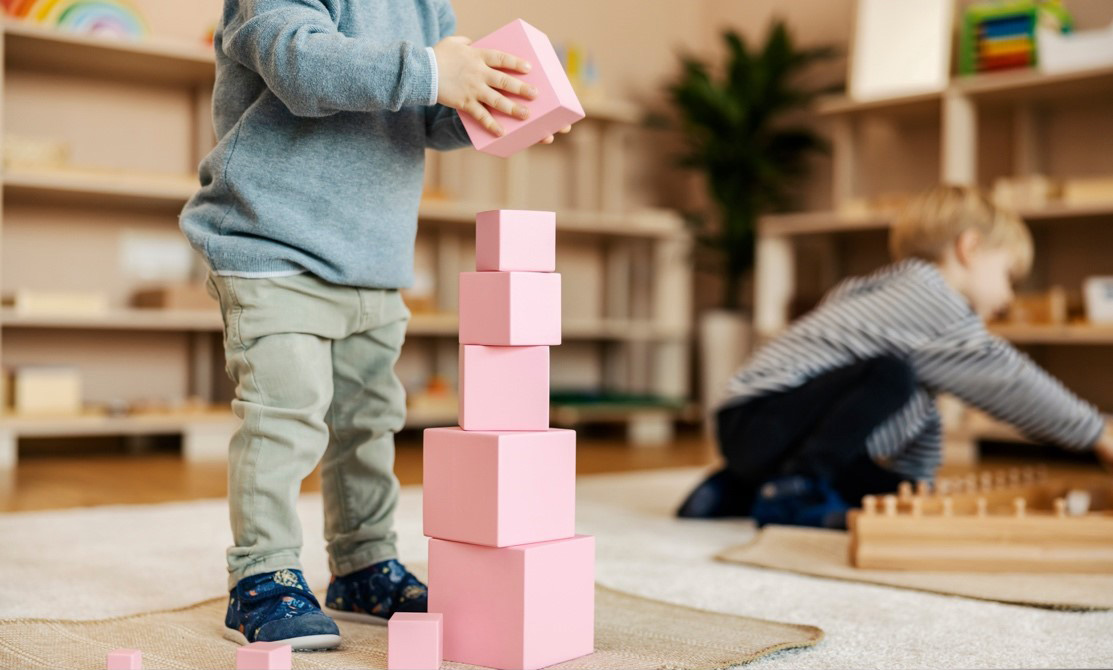
C2AE/ Steve Jurczuk-stock.adobe.com
|
Designing Montessori Learning Environments
 By Steve Jurczuk, AIA, LEED AP
August 1, 2024
By Steve Jurczuk, AIA, LEED AP
August 1, 2024
Think back to your childhood. How long was your attention span at five, ten, or fifteen years old? How did you learn best, through a hands-on project or a lecture?
According to Dr. Maria Montessori, the founder of the Montessori philosophy of education, children of all ages generally learn best when they’re allowed to explore their environments and develop skills at their own pace.
Because of the Montessori philosophy’s emphasis on hands-on learning, the child’s surroundings are a crucial component of effective teaching. From the classroom to the furniture to the site, the learning environment makes a difference. As an architect with nearly three decades of experience designing schools, I’m inclined to agree with Dr. Montessori here.
Whether you are a school administrator, a teacher, or a parent, you might be wondering how a well-designed facility supports Dr. Montessori’s vision for student-driven education. Here is what you need to know about Montessori school design, from pre-kindergarten to graduation.
Anatomy of a Montessori Classroom
The Montessori method is founded on creative, experiential learning. Classrooms are neither sparse nor cluttered but provide enough structure and stimulation to spark curiosity. Montessori classrooms can be larger than traditional classrooms and often include a kitchenette. These spaces are organized and zoned into “labs” for different activities rather than oriented toward a board at the front of the room. The child is the focus of the classroom, not the educator.
Additionally, Montessori classrooms are typically biophilic, meaning they are designed to connect to nature on several levels. A biophilic Montessori classroom may include ample windows to provide daylight and views outside, natural materials such as wood and stone, plant life, and colors and textures reminiscent of nature. There is strong evidence to suggest that biophilic design reduces stress and enhances learning.
Montessori Buildings for All Ages
Montessori schools don’t separate students from year to year but rather by developmental stages. A single classroom typically accommodates students within three years of each other. These multi-age groupings enable younger students to learn from older students, while the older students develop leadership and social skills by helping younger students.
Early childhood and elementary classrooms resemble the home and are designed to nurture everyday life skills. Children learn independently or in small groups at tables or on floor mats. Materials are grouped by subject matter. Shelves, sinks, and furniture are all scaled down for small users. The teacher’s role is to observe students and offer support and direction as needed. The students plan their tasks at the beginning of the day.
As the child completes elementary level learning, Montessori classrooms are less focused on the home and instead offer a variety of materials and workspaces for exploration and the prepare students to contribute to society.
According to the Montessori Society, these spaces instill leadership and collaboration through student-led meetings, activities to encourage diverse ideas and perspectives, and an appreciation of differences.
Features Outside the Classroom
A hallmark of Montessori education is its emphasis on outdoor learning, no matter the climate. Most classrooms will offer access to the outdoors. On a Montessori school’s site, you’ll typically find plenty of space for outdoor play in a natural environment, a garden, and community-friendly amenities.
Like the classroom, Montessori playgrounds tend to be zoned. Instead of one large play structure, you might find several smaller structures for independent play. Portions of the outside will offer shelter from the sun or inclement weather, while other areas are open.
Montessori Evolution
Although the first Montessori school opened over 100 years ago, the goal was the same then as it is now: to equip children with the practical skills they need to thrive in the world. And because the world is constantly evolving, so are Montessori schools. Today, elementary classrooms often take advantage of technology to let students research ideas. Older students have access to laptops, iPads, or tablets to learn CAD, experiment with photo editing, or record a podcast. While technology is ever-changing, the Montessori philosophy instills curiosity and problem-solving, which will allow students to adapt to whatever changes may come in the future.
Similarities to Traditional Schools
Many of the trends we see in traditional schools—safety and security, sustainability, staff and student wellness, and community connections—are also important for Montessori schools. As designers, we aim to create spaces that empower students and the village of educators, parents, and community partners who guide them. We’re here to listen to you and create the right space for your district.
About the Author:
Steve Jurczuk, AIA, LEED AP, is an experienced project manager, licensed architect, and public servant. In addition to his nearly 30 years in the design industry, Steve is a proven leader as captain of the Dorr Fire Department and a member of the Allegan County Board of Public Works in Michigan. Steve has managed dozens of projects for educators, with construction costs totaling over $200 million.